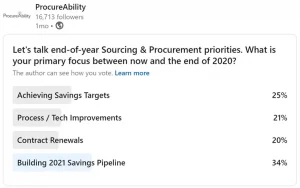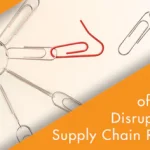
We are all familiar with the Q4 “crunch time” for Procurement; contracts are up for renewal, suppliers want to cut a deal, and stakeholders are trying to exhaust their remaining budgets. While it’s easy to get caught up in the day-to-day, is it not prudent to wait until next year to develop a new procurement strategy. A recent LinkedIn poll, conducted by Arroyo Strategy, highlighted that many businesses have in fact turned their focus to next year’s goals with achieving savings targets trailing as the second focus.
Check out the poll’s results here:
How to Start Planning Out Your Strategy
It is easy to say, “focus on next year’s strategy,” but where do you begin?
Many procurement organizations see annual planning as a time to set savings goals and to identify sourcing opportunities that will allow them to meet these goals. This is an understandable approach since it paves the way to understanding the coming year’s workload, which can in turn, inform budgets, resource needs and org structure. However, rushing off to plan your savings pipeline without considering your company’s business goals can quickly get you out of synch with your stakeholders. Instead of jumping to the savings plan, it’s helpful to take a step back and assess what the business wants you to deliver and how you can meet those expectations. With this knowledge, you can set an intentional plan and strategic roadmap for the coming year.
5 Steps to Creating a Procurement Strategy
This high-level procurement assessment doesn’t have to be complicated. In fact, it can be done in 5 simple steps, as shown below:

Step 2: Identify Procurement’s role in achieving that goal. What are you expected to deliver to meet the goal? How will you help the company (and your stakeholders) be successful? What is your value in the process?
Step 3: Create a Requirements Checklist of items needed for successful delivery of the expectations defined in Step 2. For example, if your role is to negotiate complex IT agreements, you need resources who have that experience and have the time to devote to the project.
Step 4: Identify the items in Step 3 that you can fulfill today. Be honest. For example, do you have the right market intelligence? Do you have sufficient category expertise on the team?
Step 5: Compare the results from Steps 3 and 4 to identify gaps/obstacles and potential solutions to close them.
Once you have completed these steps, you will clearly see where you need to focus and how you can get on the path to success. These elements can formulate your strategy for the next 12 months, and beyond.
Common Pitfalls to Avoid in Your Strategy Creation
The most common challenge facing procurement organizations that don’t think through their strategy this way is an overwhelming load of reactive, tactical work – if your stakeholders don’t see that you have a clear plan to help them, they will wait to engage you until the last possible moment. Thinking higher-level and longer-term requires Procurement to consider how it supports the company as a whole.
Procurement has a big job ahead in 2021; after a year like 2020, we must appreciate the importance of a strategic plan to drive the organization to achieve its full potential. Need further assistance with your procurement strategy creation? Contact us at Arroyo Strategy today to learn how we can help.
Subscribe to Arroyo Strategy Insights to access whitepapers, presentations, plus our latest thought leadership.



